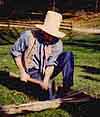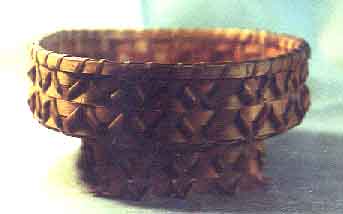Weaving Splint Baskets

Interpreter pounding an ash log to remove splints at Old Sturbridge Village
|
Natives of the northeast made their woodsplints from the trees
of Brown, Black Ash (Fraxinus nigra) and Oaks. In addition to these splints,
sweetgrass, (sometimes braided) and in much later historic times,
twisted Hong Kong cord (an imported twisted grass) are sometimes woven
in. Ash is the preferred material for fine woodsplint basket making. Some sturdy workbaskets were made with oak for their durability but the time-enduring silky appearance of woodsplint baskets comes from ash. The best ash trees for basket making are those which grow vigorously during the summer months, creating the dense growth rings which are separated by pithy winter layers. When these porous layers of the ash treeís rings are pulverized, the wood comes apart into separate dense layers used for woodsplints

Tantaquideon Splitter |
Before pounding an ash log to remove the splints, it must be selected, cut and emersed in a body of water, swamp, bog or pond for at least a year. Once thoroughly soaked the ash log must be quickly debarked using a drawknife or a spud specifically designed for the task. While it still retains itís moisture, the log is scored along itís length and the width of the splints following the natural grain of the wood. The scored log is then pounded down itís length at close intervals with a wooden maul to separate the layers and lift the woodsplints.

Beaver Incisor |
If the raw woodsplints were thick they could be further slit down with a device called a splitter, of two lengths of wood, using oneís knees to apply pressure to the splints, which are pulled apart with oneís hands. The splints would be coiled up, dried and stowed for later finishing. Splints were soaked again and refined with planes, drawshaves, crooked knives, and basket guages to trim splints to the proper thickness and width needed.
At first Native woodsplints were
made freehand, without using special knives or gauges. Some basket
tools have Native beginnings, such as the crooked knife used to
thin woodsplints (and for woodworking in general). Crooked knives
originally had a beaver incisor for a blade (Speck 1915), but
by the 1600's it had a metal blade, set at an angle, into a wooden
handle (Snow 1980).
Nipmucs, Mohegans, Pequots,
Niantics, and Wampanoags living in region east of the Connecticut
River eventually used a draw knife, (a blade with a handle at
either end held with both hands), to shave down woodsplints; so
the splints from this region resulted squared edges. Other Native groups
such as the Schaghticoke, Mahican, Paugusset, and Tunxis living
in the western region of southern New England used the crooked
knife (held in one hand) to thin the wood, leaving the splints
with tapering, beveled edges.

Large, bold 'curly-que' twists
on a basket from southern New England

Small, intricate porcupine 'curly-que' twists
on a basket from northern New England |
|
The baskets of groups living to
either side of the Connecticut River were also woven in different
ways. Nipmucs, in imitation of Pequot basketry, often wove in
a band of narrow-fitting splints or they painted 'bar' designs
that have the same visual effect. Baskets of the western region
of southern New England are noted for the 'porcupine twist'; a
way of twisting the splint weft into a 'curlicue' as it is woven
over the splint warps. The Schaghticoke associate the splint 'curlicue'
with the form of a shell, and similar techniques are used in traditional
porcupine quill work (Speck 1915).






 Splint Basket Traditions
Splint Basket Traditions
